Experimental Study on Microwave Drying Aluminum Hydroxide
Abstract
1. Introduction
2. Materials and Experimental Methods
2.1. Experimental Materials
2.2. Experimental Setup and Methods
2.2.1. Experimental Setup
2.2.2. Experimental Methods
- (a)
- The continuous cyclic experiments were carried out with a sample mass of 50 g with different microwave powers and processing times of 20, 30, and 40 min, with the aim of investigating the effect of drying time on the drying effect, as well as the effect of microwave power and initial material mass on the properties of the output of the dried material. The continuous cycle experiments described refer to experiments without time intervals, as shown in Table 1. L1-2 was started immediately after the end of L1-1, followed by L1-3, and so on, until all nine case experiments were completed.
- (b)
- Under the conditions of a sample mass of 250 g, a processing time of 30 min, and a material target temperature of 150 °C, the effects of microwave power changes on the material heating rate, drying effect, and the corresponding changes in material properties were investigated. Among them, the design of the microwave heating and drying of the maximum temperature of 150 °C, with a drying time of 30 min, taking into account the reasons for energy consumption, that is, when the processing time has been full of 30 min and the temperature is lower than 150 °C, to stop the microwave and take out the material weighed and analyzed. When the temperature rises to 150 °C but the time is less than 30 min, the use of heat preservation to extend the processing time to 30 min.
2.2.3. Calculation Methods
3. Results and Analysis
3.1. Microwave Drying Process and Results
3.1.1. Analysis of Microwave Heating Characteristics
3.1.2. Effect of Microwave Power on Dehydration Ratio
3.1.3. Effect of Microwave Power on Proportion of Dry Matter
3.2. Characterization Analysis
3.2.1. Phase Analysis
3.2.2. Appearance, Morphology, and Particle Size Analysis
3.2.3. FTIR Spectrum Analysis
3.2.4. Dielectric Properties Analysis
3.2.5. Simple Economic Analysis
4. Conclusions
- (1)
- Microwave drying can remove free water from aluminum hydroxide materials at a fast speed. When a fixed quantity of the materials is dried, the drying time is shorter at a higher microwave power and a faster heating rate.
- (2)
- The dehydration ratio and the proportion of dry matter of aluminum hydroxide are related to the final temperature of the material. At temperatures above 220 °C, the crystalline water in aluminum hydroxide is removed, and a low-temperature phase transition to boehmite occurs. Within the range of experimental parameters, the optimal temperature is 150 °C. The XRD spectra indicate that at 150 °C, aluminum hydroxide does not undergo low-temperature phase transition and has a stable composition.
- (3)
- According to the morphology and particle size analyses of aluminum hydroxide samples dried by the traditional and microwave processes, the particle size and morphology of the two types of samples have a slight difference. The test results of the dielectric properties of the samples dried by microwaves show that the dielectric constant and dielectric loss are tremendously reduced due to the removal of moisture.
Author Contributions
Funding
Institutional Review Board Statement
Informed Consent Statement
Data Availability Statement
Conflicts of Interest
References
- Shi, Y.; Jiang, K.-X.; Zhang, T.-A. Cleaner extraction of alumina from coal fly ash: Baking-electrolysis method. Fuel 2020, 273, 117697. [Google Scholar] [CrossRef]
- Shi, Y.; Jiang, K.-X.; Zhang, T.-A.; Zhu, X.-F. Simultaneous and clean separation of titanium, iron, and alumina from coal fly ash in one spot: Electrolysis-hydrolysis method. Sep. Purif. Technol. 2022, 294, 121247. [Google Scholar] [CrossRef]
- Yoon, D.Y.; Kang, S.-J.L.; Eun, K.Y.; Kim, Y.-S. Synthesis of Aluminum Monohydroxide Nanofiber by Electrolysis of Aluminum Plates. J. Korean Powder Metall. Inst. 2006, 13, 108–111. [Google Scholar] [CrossRef]
- Orasa, P.; Somjai, C. Improvements of Natural Rubber for Flame Resistance. Songklanakarin J. Sci. Technol. 2010, 32, 299–305. [Google Scholar]
- Sarawut, K.; Pohnpawee, N.; Kritapas, L.; Nisanart, T.; Rakchart, T. Reversible thermochromic polydiacetylene/zinc-aluminium layered double hydroxides nanocomposites for smart paints and colorimetric sensors: The crucial role of zinc ions. Colloids Surf. A Physicochem. Eng. Asp. 2021, 610, 125733. [Google Scholar] [CrossRef]
- Chen, P.; Ma, B.; Tan, H.; Liu, X.; Zhang, T.; Qi, H.; Peng, Y.; Yang, Q.; Wang, J. Effects of amorphous aluminum hydroxide on chloride immobilization in cement-based materials. Constr. Build. Mater. 2020, 231, 117171. [Google Scholar] [CrossRef]
- Wang, L.; Mei, L.; Zang, Z.; Cai, Y.; Jiang, P.; Zhou, L.; Du, Z.; Yang, L.; Gu, Z.; Liu, T.; et al. Aluminum hydroxide exposure induces neurodevelopmental impairment in hESC-derived cerebral organoids. Ecotoxicol. Environ. Saf. 2023, 256, 114863. [Google Scholar] [CrossRef] [PubMed]
- Yang, C. Light Metal Metallurgy; Metallurgical Industry Press (MIP): Beijing, China, 1991; pp. 61–65. (In Chinese) [Google Scholar]
- Peng, X.; Wu, Y.; Li, S.; Zhang, J.; Song, Y. Energy consumption analysis for evaporation process in alumina refinery. J. Cent. South Univ. 2013, 44, 367–371. (In Chinese) [Google Scholar]
- Hua, Y.; Cai, C.; Cui, Y. Microwave-enhanced roasting of copper sulfide concentrate in the presence of CaCO3. Sep. Purif. Technol. 2006, 50, 22–29. [Google Scholar] [CrossRef]
- Sharma, P.; Osama, K.; Varjani, S.; Farooqui, A.; Younis, K. Microwave-assisted valorization and characterization of Citrus limetta peel waste into pectin as a perspective food additive. J. Food Sci. Technol. 2023, 60, 1284–1293. [Google Scholar] [CrossRef]
- Fan, K.; Zhang, M.; Mujumdar, A.S. Recent developments in high efficient freeze-drying of fruits and vegetables assisted by microwave: A review. Crit. Rev. Food Sci. Nutr. 2019, 59, 1357–1366. [Google Scholar] [CrossRef] [PubMed]
- Mizuno, N.; Kosai, S.; Yamasue, E. Microwave-based extractive metallurgy to obtain pure metals: A review. Clean. Eng. Technol. 2021, 5, 100306. [Google Scholar] [CrossRef]
- Ma, A.; Peng, J.; Xia, H.; Zuo, Y. Dielectric properties and temperature increase of zinc oxide dust derived from volatilization in rotary kilns. J. Microw. Power Electromagn. Energy 2014, 48, 25–34. [Google Scholar] [CrossRef]
- Liu, P.; Zhang, L.; Liu, B.; He, G.; Peng, J.; Huang, M. Dielectric Properties Measurement for Microwave Synthesis of Titanium Carbide with Ti-bearing Blast Furnace Slag. Int. J. Miner. Metall. Mater. 2021, 28, 88–97. [Google Scholar] [CrossRef]
- Pawelski, D.; Plonska-Brzezinska, M.E. Microwave-Assisted Synthesis as a Promising Tool for the Preparation of Materials Containing Defective Carbon Nanostructures: Implications on Properties and Applications. Materials 2023, 16, 6549. [Google Scholar] [CrossRef] [PubMed]
- Liu, Z.; Yang, S.; Wang, Z.; Ji, N.; Li, D.; Wu, Y. Preparation of bamboo-epoxy resin materials with microwave assistance. J. Mater. Res. Technol. 2022, 18, 3266–3272. [Google Scholar] [CrossRef]
- Nandihalli, N.; Gregory, D.H.; Mori, T. Energy-Saving Pathways for Thermoelectric Nanomaterial Synthesis: Hydrothermal/Solvothermal, Microwave-Assisted, Solution-Based, and Powder Processing. Adv. Sci. 2022, 9, 2106052. [Google Scholar] [CrossRef] [PubMed]
- Gabriel, C.; Gabriel, S.; Grant, E.H.; Grant, E.H.; Halstead, B.S.J.; Mingos, D.M.P. Dielectric parameters relevant to microwave dielectric heating. Chem. Soc. Rev. 1998, 27, 213–224. [Google Scholar] [CrossRef]
- Leonelli, C.; Mason, T.J. Microwave and ultrasonic processing: Now a realistic option for industry. Chem. Eng. Process. Process Intensif. 2021, 49, 885–900. [Google Scholar] [CrossRef]
- Yan, Y.; Jing, C.; Song, Z.; Zhao, X.; Wang, W.; Mao, Y.; Sun, J. Effect of hot air and microwave drying on the quality of coal slime. Chem. Ind. Eng. Prog. 2019, 38, 122–127. (In Chinese) [Google Scholar]
- Ru, S.; Ceng, H.; Yanxiong, F.; Ji, H. Effect of microwave drying and hot air drying on quality of Jin Xuan tea. Chem. Ind. Eng. Prog. 2012, 31, 76–79. (In Chinese) [Google Scholar]
- Guo, L.; Tu, H.; Jinhui, P.; Yin, S.; Zhang, L.; Li, Z. Experimental study on the microwave drying of hydrometallurgy mud. Chem. Ind. Eng. Prog. 2015, 34, 3472–3475. (In Chinese) [Google Scholar] [CrossRef]
- Guo, L.; Zhang, L.; Peng, J.; Duan, X.; Wang, X. An optimization study of microwave drying process for scheelite concentrate with RSM. Min. Metall. 2012, 21, 54–57. (In Chinese) [Google Scholar] [CrossRef]
- Bin, Z. Study on Calcination Process and Crystal Transformation of Aluminum Hydroxide in Microwave Field; Kunming University of Technology: Kunming, China, 2012. (In Chinese) [Google Scholar]
- Tian, C.; Zhou, J.; Ren, C.; Omran, M.; Zhang, F.; Tang, J. Drying kinetics of microwave-assisted drying of leaching Rresidues from hydrometallurgy of Zinc. Materials 2023, 16, 5546. [Google Scholar] [CrossRef]
- Koua, B.K.; Kof, P.M.E.; Gbah, P. Evolution of shrinkage, real density, porosity, heat and mass transfer coefficients during indirect solar drying of cocoa beans. J. Saudi Soc. Agric. Sci. 2017, 18, 72–82. [Google Scholar] [CrossRef]
- Crank, J. The Mathematics of Diffusion; Clarendon Press: Oxford, UK, 1975. [Google Scholar]
- Fan, W.; Li, W.; Han, D.; Zheng, C. Influence of particle size on kinetics of low temperature phase transformation of aluminum hydroxide. Chem. Ind. Eng. Prog. 2020, 39, 1101–1107. (In Chinese) [Google Scholar]
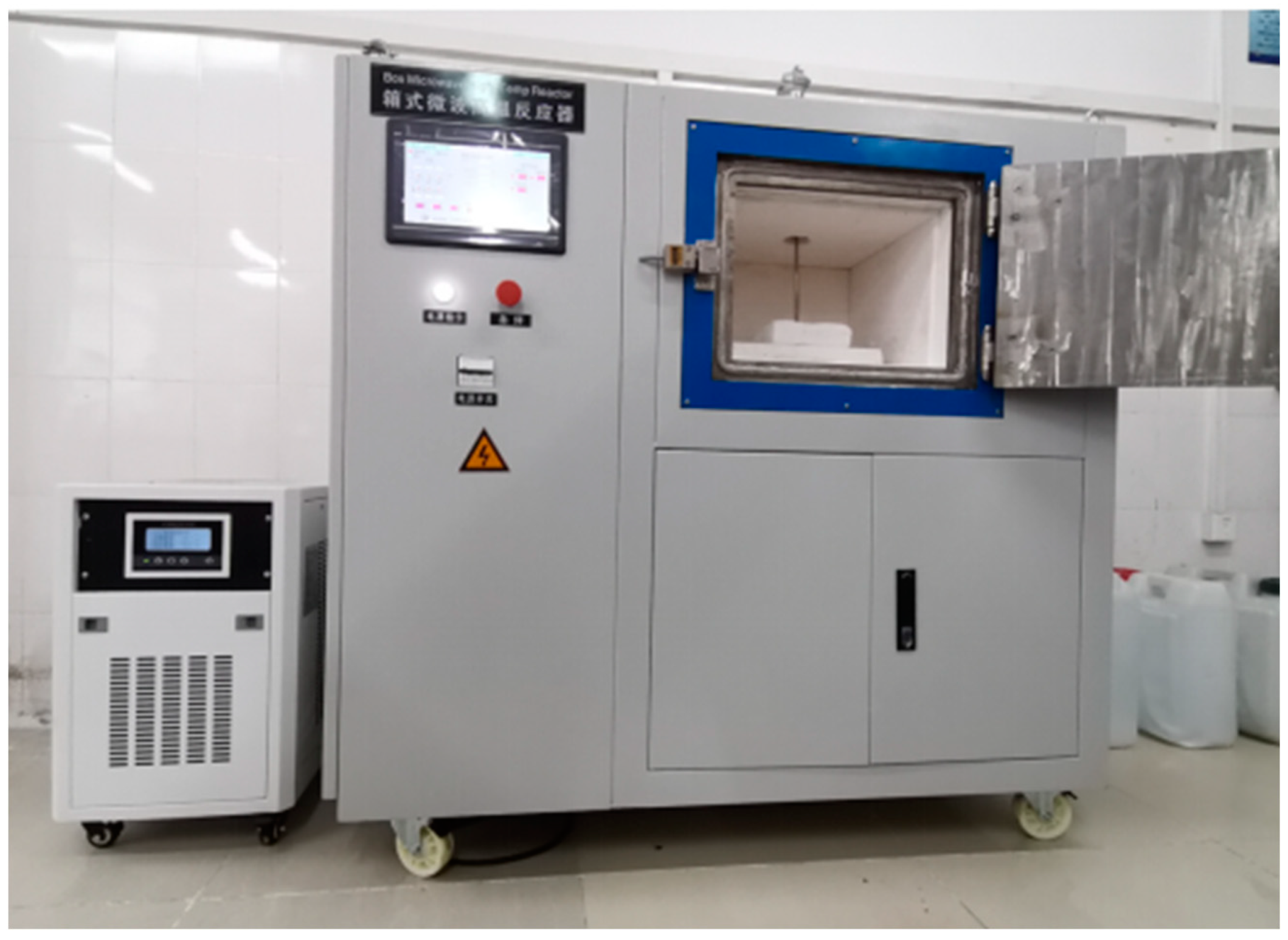
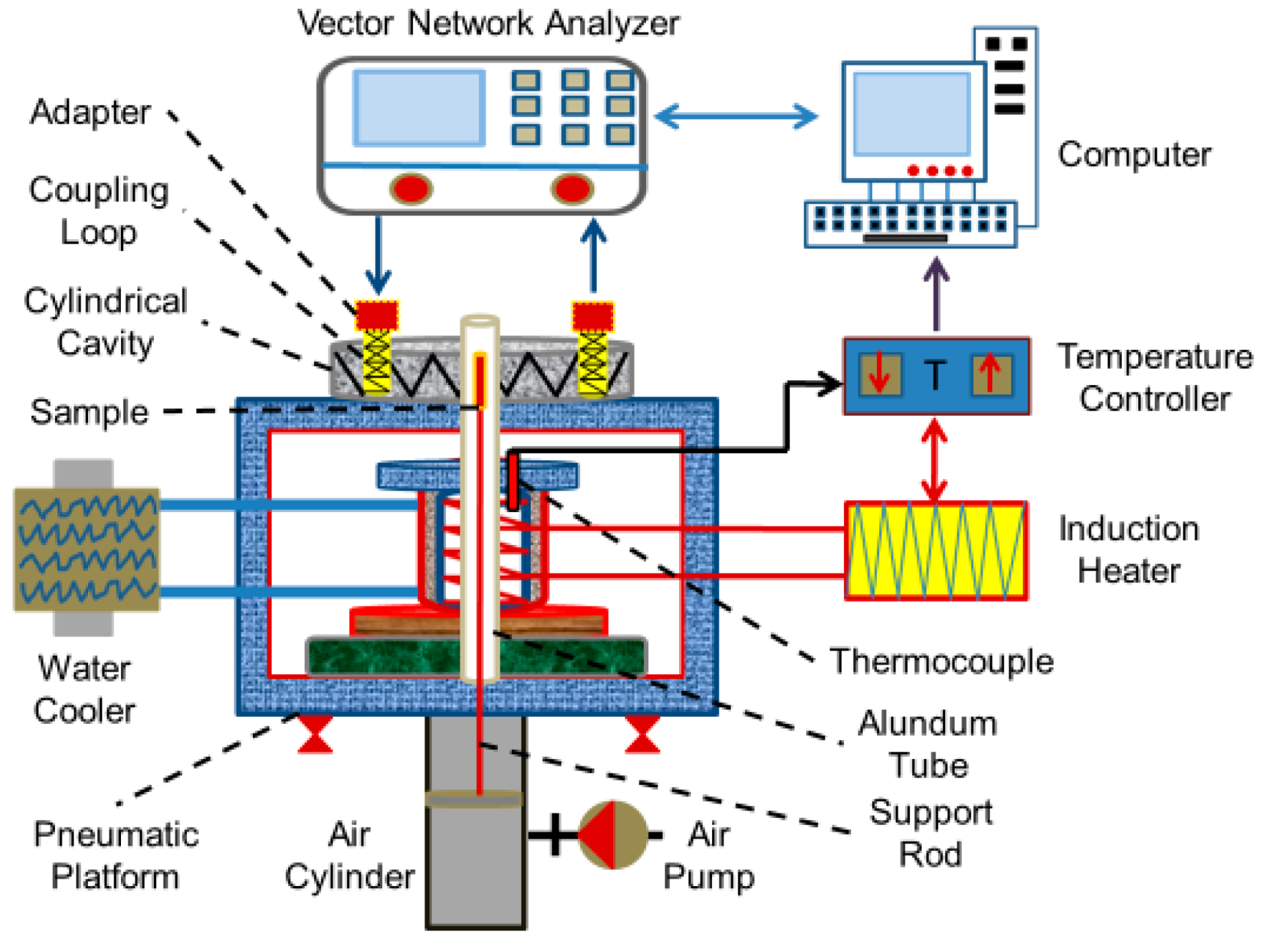

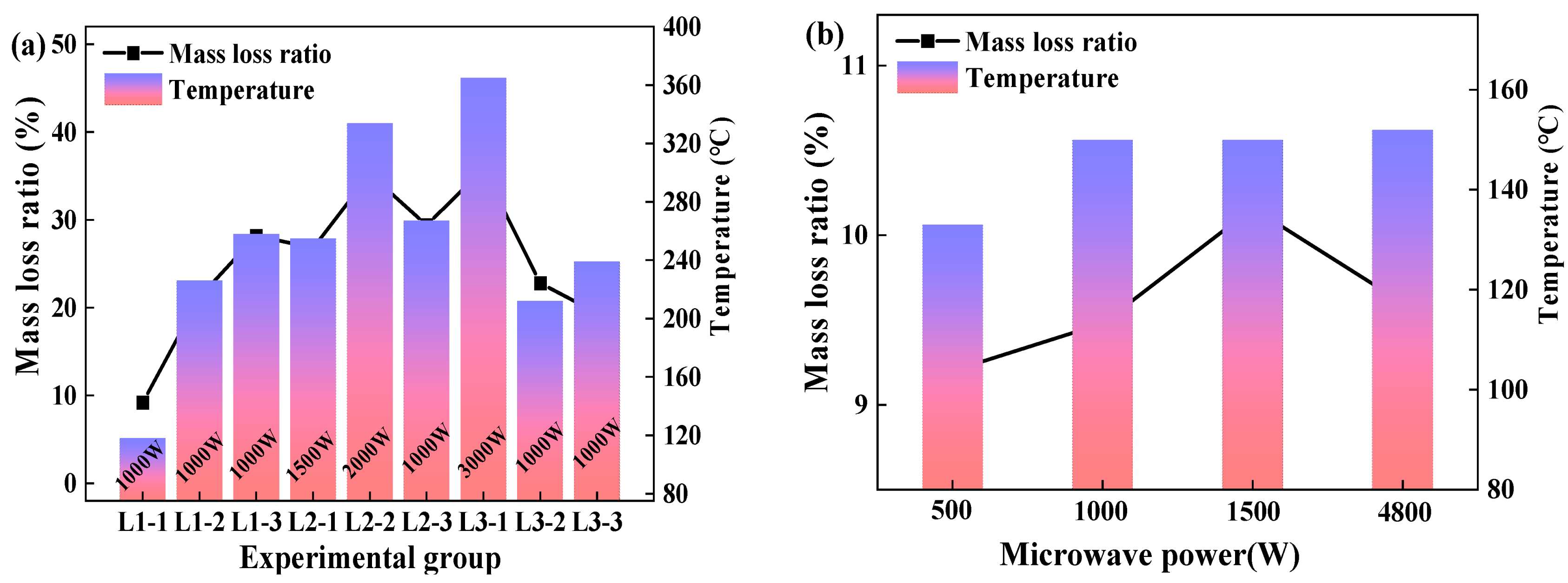
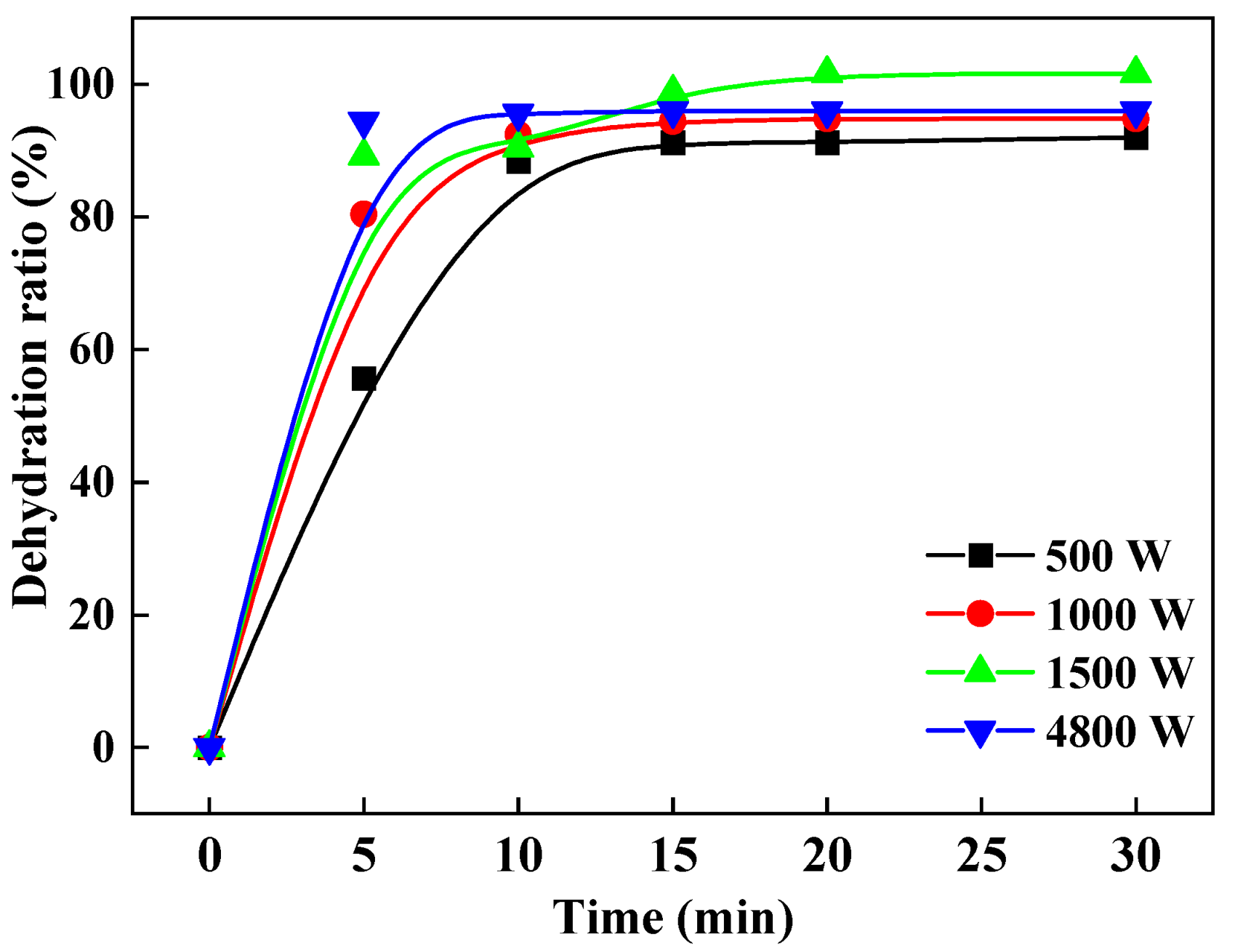
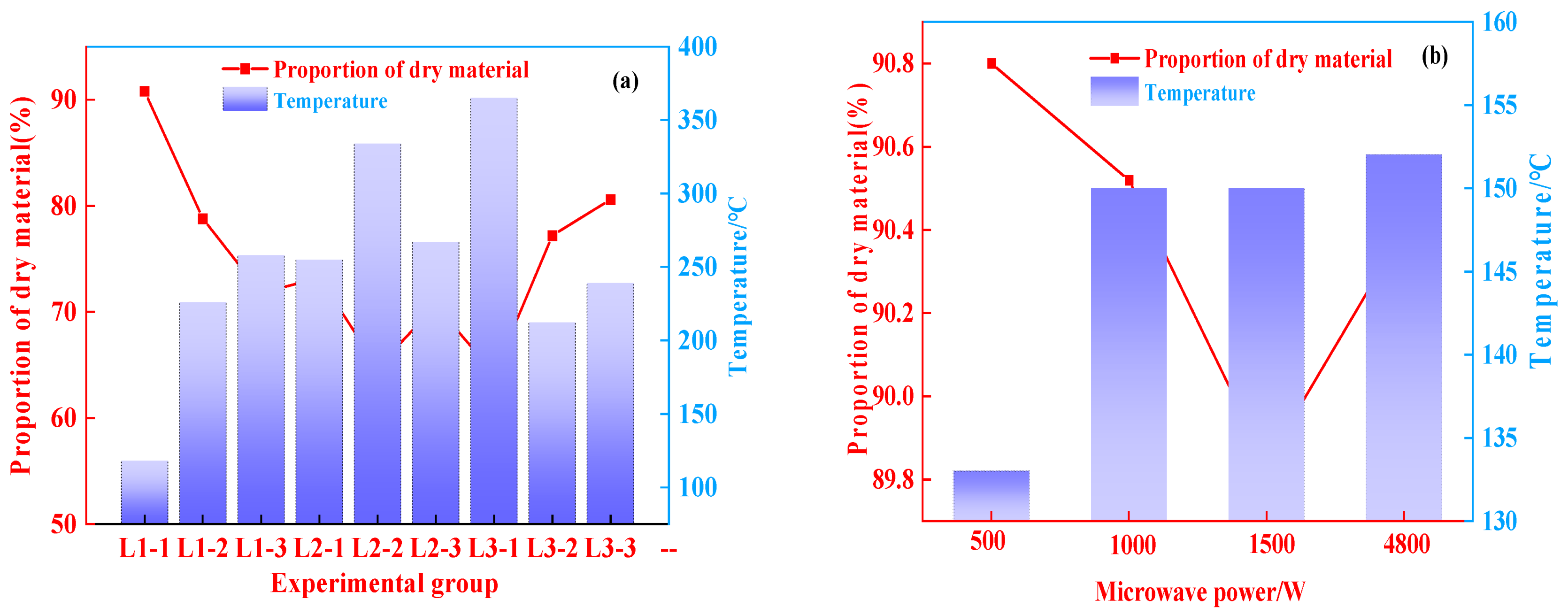
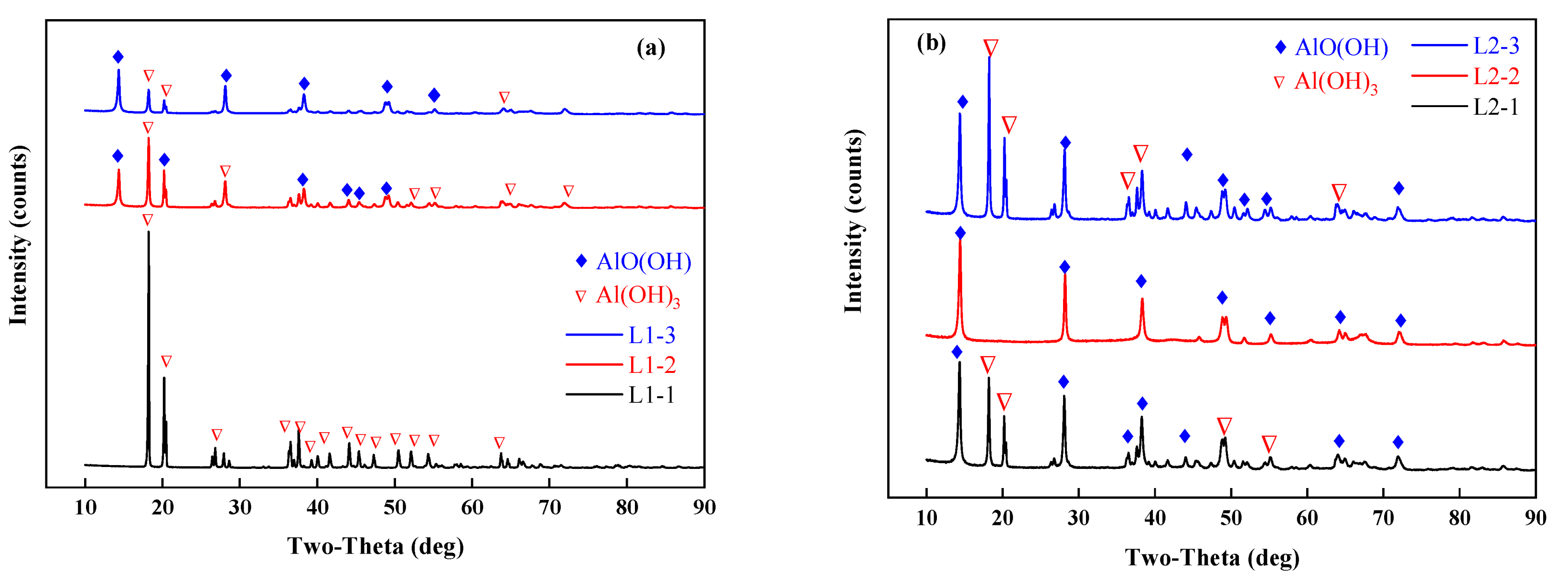

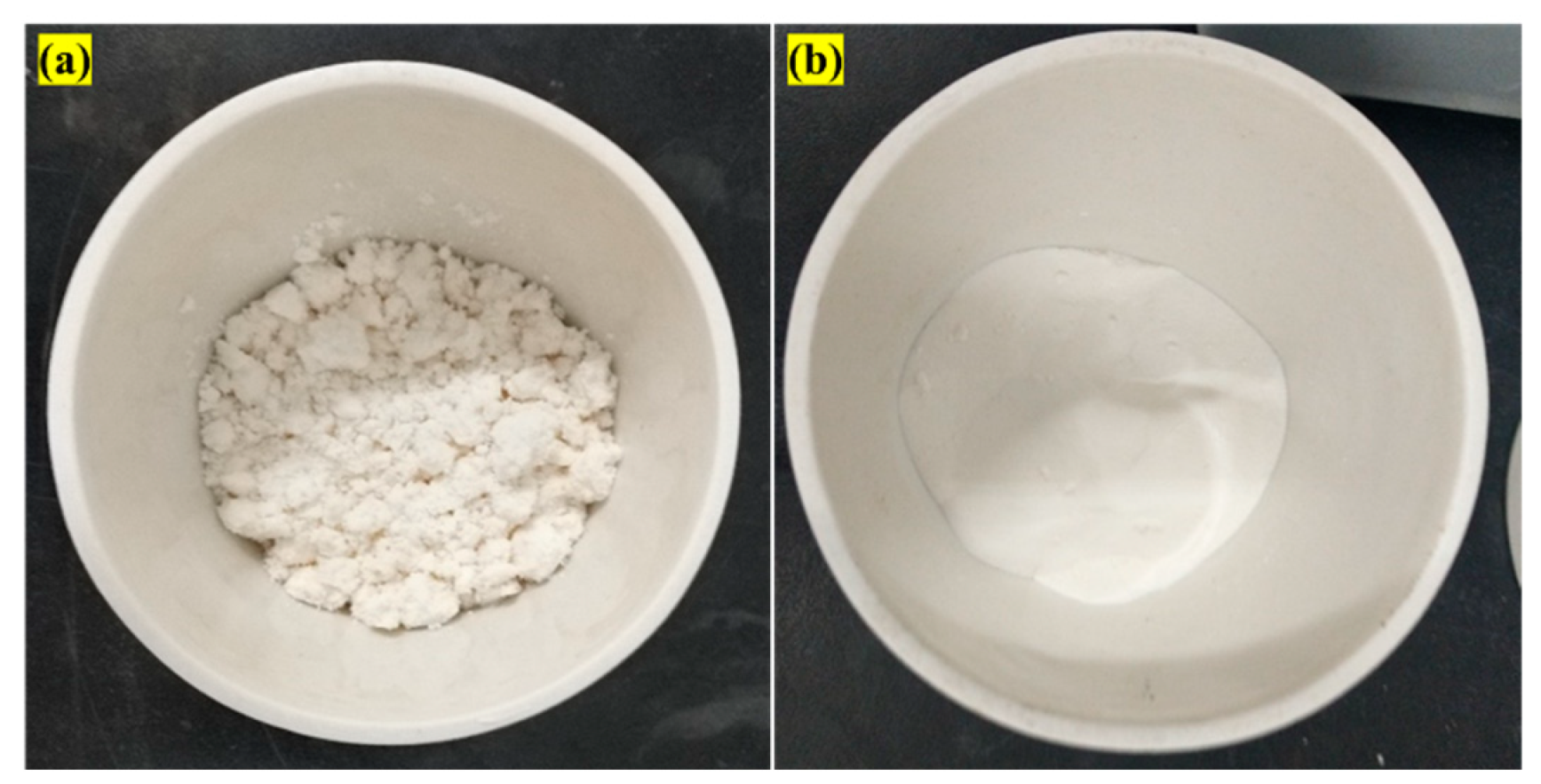


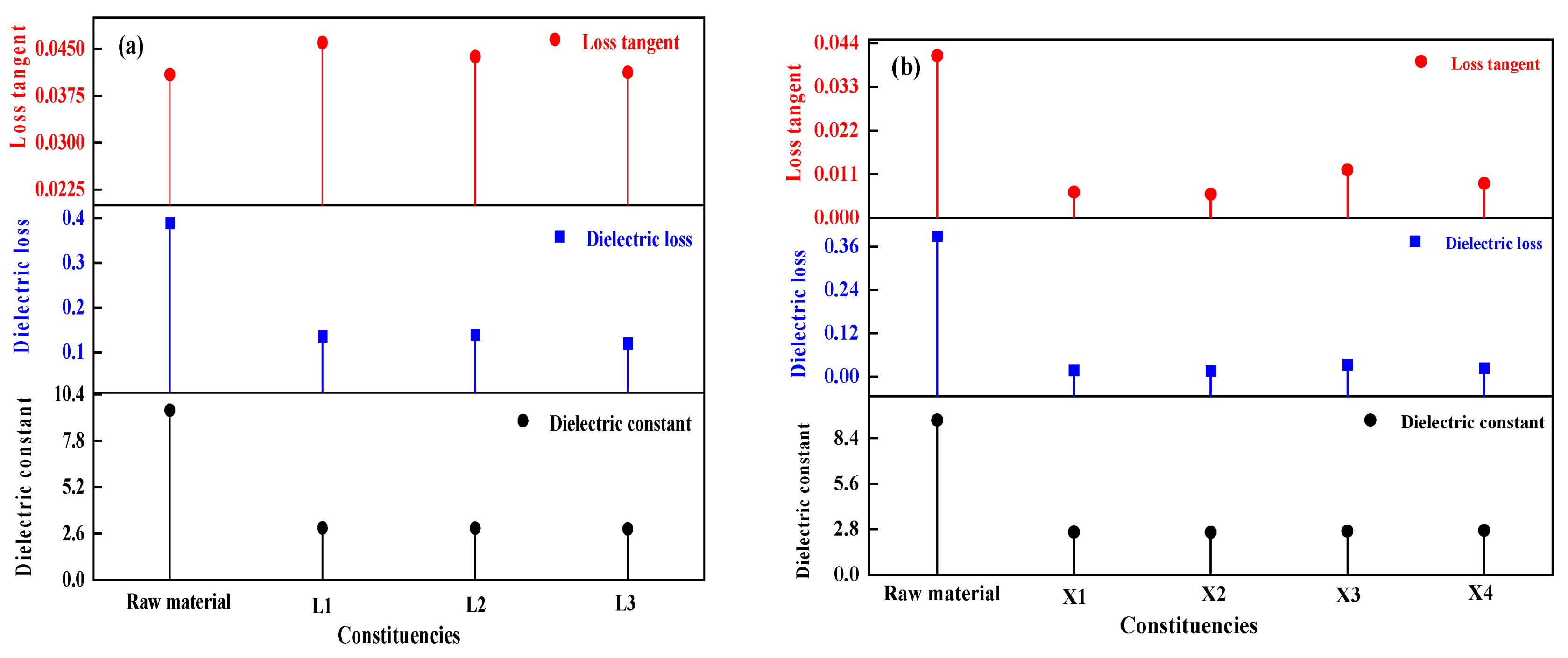
| Experiment Number | Sample Mass/g | Microwave Power/W | Drying Time/min | Target Temperature/°C |
|---|---|---|---|---|
| L1-1 | 50 | 1000 | 20 | — |
| L1-2 | 1000 | 30 | ||
| L1-3 | 1000 | 40 | ||
| L2-1 | 1500 | 20 | ||
| L2-2 | 2000 | 30 | ||
| L2-3 | 1000 | 40 | ||
| L3-1 | 3000 | 20 | ||
| L3-2 | 1000 | 30 | ||
| L3-3 | 1000 | 40 | ||
| X1 | 250 | 500 | 30 | 150 |
| X2 | 1000 | |||
| X3 | 1500 | |||
| X4 | 4800 |
| Experimental Conditions | Constituencies | Numbering | Particle Size Distribution/μm | ||
|---|---|---|---|---|---|
| D10 | D50 | D90 | |||
| Microwave drying | L1 | 1 | 37.58 | 78.71 | 141.75 |
| 2 | 37.45 | 78.06 | 140.51 | ||
| 3 | 39.48 | 77.63 | 138.34 | ||
| L2 | 1 | 40.23 | 80.14 | 141.37 | |
| 2 | 40.57 | 79.18 | 138.99 | ||
| 3 | 39.14 | 76.69 | 136.15 | ||
| L3 | 1 | 40.01 | 79.19 | 139.81 | |
| 2 | 35.61 | 73.16 | 131.10 | ||
| 3 | 40.56 | 79.43 | 138.94 | ||
| X | X1 | 40.78 | 80.46 | 140.67 | |
| X2 | 36.12 | 77.32 | 138.91 | ||
| X3 | 40.04 | 80.18 | 140.69 | ||
| X4 | 41.52 | 81.94 | 143.20 | ||
| Traditional drying | — | Blast drying oven | 38.71 | 78.89 | 141.61 |
| Microwave Power (W) | Heating Time (min) | Mass (g) | Experimental Energy Consumption (kW·h) | Energy Consumption per Ton of Material with Microwave (kW·h/ton) |
|---|---|---|---|---|
| 500 | 31 | 250 | 0.26 | 10,333 |
| 1000 | 21 | 0.35 | 14,000 | |
| 1500 | 11 | 0.28 | 11,000 | |
| 4800 | 7 | 0.56 | 22,400 |
Disclaimer/Publisher’s Note: The statements, opinions and data contained in all publications are solely those of the individual author(s) and contributor(s) and not of MDPI and/or the editor(s). MDPI and/or the editor(s) disclaim responsibility for any injury to people or property resulting from any ideas, methods, instructions or products referred to in the content. |
© 2024 by the authors. Licensee MDPI, Basel, Switzerland. This article is an open access article distributed under the terms and conditions of the Creative Commons Attribution (CC BY) license (https://creativecommons.org/licenses/by/4.0/).
Share and Cite
Zheng, X.; Yuan, F.; Ma, A.; Tian, S. Experimental Study on Microwave Drying Aluminum Hydroxide. Coatings 2024, 14, 687. https://doi.org/10.3390/coatings14060687
Zheng X, Yuan F, Ma A, Tian S. Experimental Study on Microwave Drying Aluminum Hydroxide. Coatings. 2024; 14(6):687. https://doi.org/10.3390/coatings14060687
Chicago/Turabian StyleZheng, Xuemei, Fuqin Yuan, Aiyuan Ma, and Shihong Tian. 2024. "Experimental Study on Microwave Drying Aluminum Hydroxide" Coatings 14, no. 6: 687. https://doi.org/10.3390/coatings14060687
APA StyleZheng, X., Yuan, F., Ma, A., & Tian, S. (2024). Experimental Study on Microwave Drying Aluminum Hydroxide. Coatings, 14(6), 687. https://doi.org/10.3390/coatings14060687





